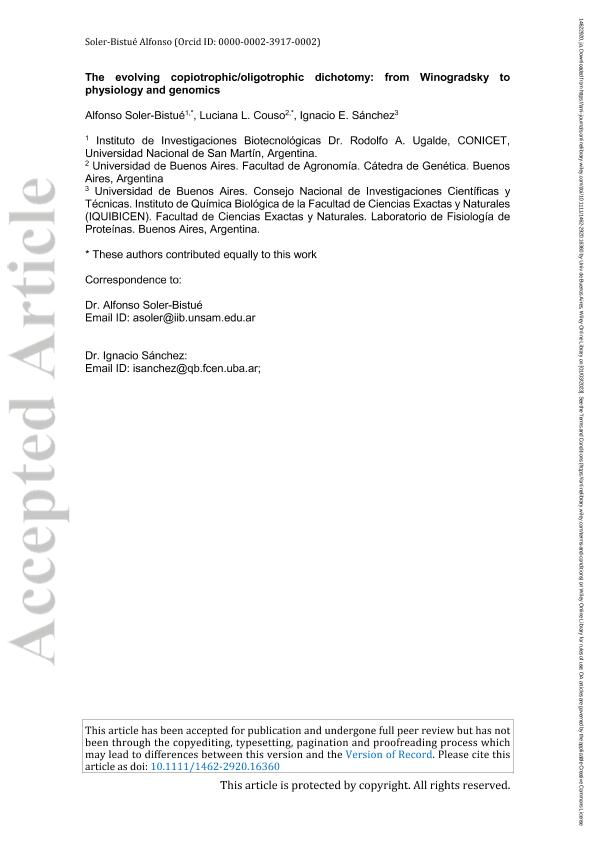Mostrar el registro sencillo del ítem
dc.contributor.author
Soler Bistue, Alfonso J. C.

dc.contributor.author
Couso, Luciana Laura

dc.contributor.author
Sánchez Miguel, Ignacio Enrique

dc.date.available
2024-02-26T12:54:31Z
dc.date.issued
2023-03
dc.identifier.citation
Soler Bistue, Alfonso J. C.; Couso, Luciana Laura; Sánchez Miguel, Ignacio Enrique; The evolving copiotrophic/oligotrophic dichotomy: From Winogradsky to physiology and genomics; Wiley Blackwell Publishing, Inc; Environmental Microbiology; 25; 7; 3-2023; 1232-1237
dc.identifier.issn
1462-2912
dc.identifier.uri
http://hdl.handle.net/11336/228348
dc.description.abstract
Nearly 100 years ago, Winogradsky published a classic communication in which he described two groups of microbes, zymogenic and autochthonous. When organic matter penetrates the soil, zymogenic microbes quickly multiply and degrade it, then giving way to the slow combustion of autochthonous microbes. Although the text was originally written in French, it is often cited by English-speaking authors. We undertook a complete translation of the 1924 publication, which we provide as Supporting information. Here, we introduce the translation and describe how the zymogenic/autochthonous dichotomy shaped research questions in the study of microbial diversity and physiology. We also identify in the literature three additional and closely related dichotomies, which we propose to call exclusive copiotrophs/oligotrophs, coexisting copiotrophs/oligotrophs and fast-growing/slow-growing microbes. While Winogradsky focussed on a successional view of microbial populations over time, the current discussion is focussed on the differences in the specific growth rate of microbes as a function of the concentration of a given limiting substrate. In the future, it will be relevant to keep in mind both nutrient-focussed and time-focussed microbial dichotomies and to design experiments with both isolated laboratory cultures and multi-species communities in the spirit of Winogradsky's direct method.
dc.format
application/pdf
dc.language.iso
eng
dc.publisher
Wiley Blackwell Publishing, Inc

dc.rights
info:eu-repo/semantics/openAccess
dc.rights.uri
https://creativecommons.org/licenses/by-nc-sa/2.5/ar/
dc.subject
oligotrofía/copiotrofía
dc.subject
velocidad de crecimiento
dc.subject
Microbiología
dc.subject
ecofisiología
dc.subject.classification
Biología Celular, Microbiología

dc.subject.classification
Ciencias Biológicas

dc.subject.classification
CIENCIAS NATURALES Y EXACTAS

dc.title
The evolving copiotrophic/oligotrophic dichotomy: From Winogradsky to physiology and genomics
dc.type
info:eu-repo/semantics/article
dc.type
info:ar-repo/semantics/artículo
dc.type
info:eu-repo/semantics/publishedVersion
dc.date.updated
2024-02-26T10:52:40Z
dc.journal.volume
25
dc.journal.number
7
dc.journal.pagination
1232-1237
dc.journal.pais
Reino Unido

dc.journal.ciudad
Londres
dc.description.fil
Fil: Soler Bistue, Alfonso J. C.. Universidad Nacional de San Martín. Instituto de Investigaciones Biotecnológicas. - Consejo Nacional de Investigaciones Científicas y Técnicas. Oficina de Coordinación Administrativa Parque Centenario. Instituto de Investigaciones Biotecnológicas; Argentina
dc.description.fil
Fil: Couso, Luciana Laura. Universidad de Buenos Aires. Facultad de Agronomía; Argentina. Consejo Nacional de Investigaciones Científicas y Técnicas; Argentina
dc.description.fil
Fil: Sánchez Miguel, Ignacio Enrique. Consejo Nacional de Investigaciones Científicas y Técnicas. Oficina de Coordinación Administrativa Ciudad Universitaria. Instituto de Química Biológica de la Facultad de Ciencias Exactas y Naturales. Universidad de Buenos Aires. Facultad de Ciencias Exactas y Naturales. Instituto de Química Biológica de la Facultad de Ciencias Exactas y Naturales; Argentina
dc.journal.title
Environmental Microbiology

dc.relation.alternativeid
info:eu-repo/semantics/altIdentifier/url/https://onlinelibrary.wiley.com/doi/10.1111/1462-2920.16360
dc.relation.alternativeid
info:eu-repo/semantics/altIdentifier/doi/http://dx.doi.org/10.1111/1462-2920.16360
Archivos asociados
